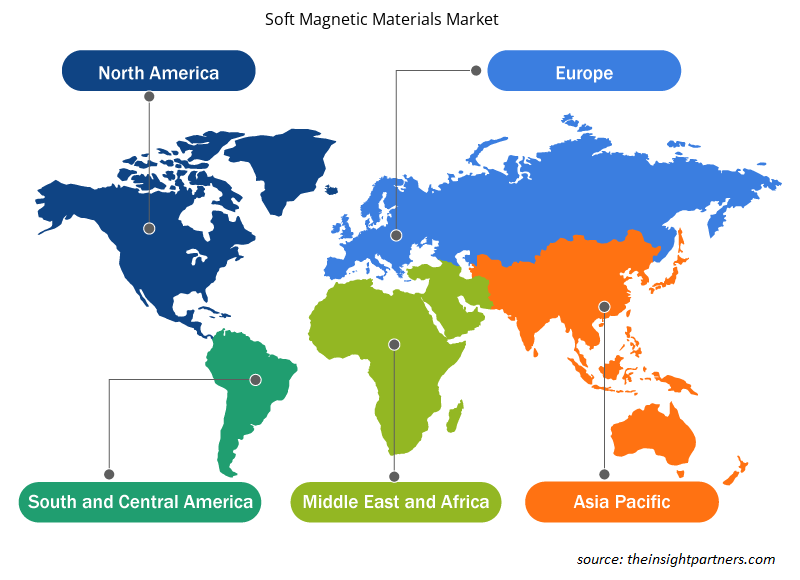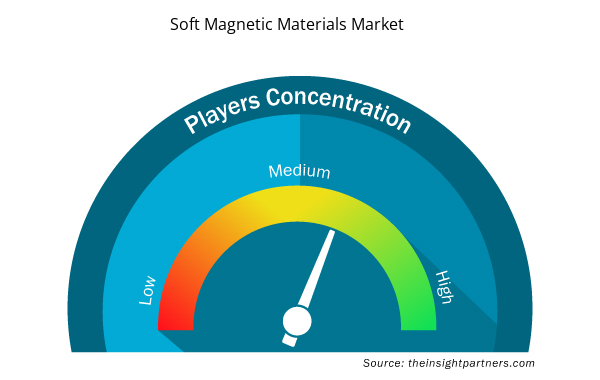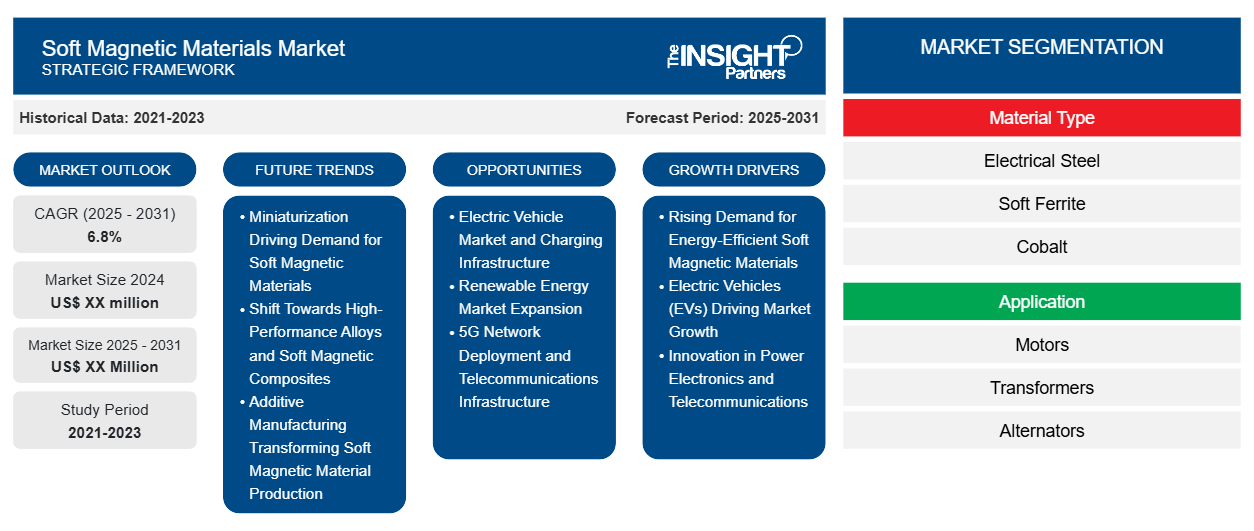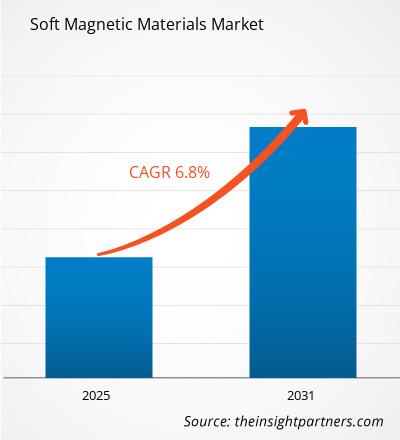Si prevede che il mercato dei materiali magnetici morbidi registrerà un CAGR del 6,8% dal 2024 al 2031, con una dimensione di mercato in espansione da XX milioni di dollari nel 2024 a XX milioni di dollari entro il 2031.
Il report è segmentato per tipo di materiale (acciaio elettrico, ferrite morbida, cobalto e altri). Il report presenta inoltre un'analisi basata sull'applicazione (motori, trasformatori, alternatori e altri). L'ambito del report copre cinque regioni: Nord America, Europa, Asia Pacifico, Medio Oriente e Africa, Sud e Centro America e paesi chiave in ogni regione. L'analisi globale è ulteriormente suddivisa a livello regionale e nei principali paesi. Il report offre il valore in USD per l'analisi e i segmenti di cui sopra.
Scopo del rapporto
Il report Soft Magnetic Materials Market di The Insight Partners mira a descrivere il panorama attuale e la crescita futura, i principali fattori trainanti, le sfide e le opportunità. Ciò fornirà spunti a vari stakeholder aziendali, come:
- Fornitori/produttori di tecnologia: per comprendere le dinamiche di mercato in evoluzione e conoscere le potenziali opportunità di crescita, consentendo loro di prendere decisioni strategiche informate.
- Investitori: condurre un'analisi completa delle tendenze in merito al tasso di crescita del mercato, alle proiezioni finanziarie del mercato e alle opportunità esistenti lungo la catena del valore.
- Enti di regolamentazione: regolamentano le politiche e le attività di controllo sul mercato allo scopo di ridurre al minimo gli abusi, preservare la fiducia degli investitori e sostenere l'integrità e la stabilità del mercato.
Segmentazione del mercato dei materiali magnetici morbidi
Tipo di materiale
- Acciaio elettrico
- Ferrite morbida
- Cobalto
Applicazione
- Motori
- Trasformatori
- Alternatori
Personalizza questo report in base alle tue esigenze
Riceverai la personalizzazione gratuita di qualsiasi report, comprese parti di questo report, o analisi a livello nazionale, pacchetto dati Excel, oltre a usufruire di grandi offerte e sconti per start-up e università
- Scopri le principali tendenze di mercato in questo rapporto.Questo campione GRATUITO includerà analisi di dati che spaziano dalle tendenze di mercato alle stime e alle previsioni.
Fattori trainanti della crescita del mercato dei materiali magnetici morbidi
- Domanda crescente di materiali magnetici morbidi a basso consumo energetico: crescente attenzione all'efficienza energetica mercati di massa nell'elettronica di consumo e nei motori elettrici alle industrie pesanti nella produzione di energia il crescente mercato dei materiali magnetici morbidi. I materiali magnetici morbidi, che includono leghe a base di ferro, ferriti e compositi magnetici morbidi, sono componenti essenziali nei dispositivi che promuovono miglioramenti nell'efficienza energetica, inclusi motori elettrici, trasformatori, induttori e alimentatori. C'è una forte domanda da parte di vari settori industriali, in particolare i settori automobilistico, elettronico e dell'automazione industriale, che stanno elaborando idee a basso consumo energetico che si traducono in minori impronte di carbonio. Questi materiali ridurranno le perdite del nucleo e miglioreranno le prestazioni nei dispositivi a basso consumo energetico.
- Veicoli elettrici (EV) che guidano la crescita del mercato: i veicoli elettrici e i veicoli elettrici ibridi apparentemente sono alcuni dei più importanti contributori alla domanda, poiché i materiali magnetici morbidi sono ampiamente utilizzati nei motori elettrici e nei sistemi elettronici di potenza. Con la necessità di una maggiore efficienza, i veicoli elettrici hanno un'immensa domanda di questi tipi di materiali. Efficienza e prestazioni ottimizzate sono integrate nelle trasmissioni elettriche e in altri componenti del sistema elettronico per stabilire quelle per i veicoli elettrici. L'aumento delle normative sulle emissioni più severe e gli incentivi da parte dei governi di tutto il mondo verso l'adozione dei veicoli elettrici accelererebbe ulteriormente il cambiamento nel settore automobilistico, con conseguente immensa crescita nel mercato dei materiali magnetici morbidi.
- Innovazione nell'elettronica di potenza e nelle telecomunicazioni: il settore automobilistico continuerebbe a subire una rapida trasformazione con innovazioni nell'elettronica di potenza, in particolare con la rapida penetrazione delle reti 5G, dei sistemi di energia rinnovabile e delle soluzioni di accumulo di energia, creando così un'immensa domanda di materiali magnetici morbidi avanzati. I materiali magnetici morbidi sono il materiale dominante per gli induttori e i trasformatori applicati negli alimentatori e nelle apparecchiature per telecomunicazioni. Contribuiscono in modo significativo all'ottimizzazione delle prestazioni del sistema di alimentazione: aumentano l'efficienza del processo di conversione dell'energia con una riduzione delle perdite di molte volte; consentono di creare dispositivi più compatti e affidabili. La domanda di componenti ad alte prestazioni ed efficienza energetica in settori come le telecomunicazioni e la generazione di energia rinnovabile (turbine eoliche, inverter solari, ecc.) contribuisce alla necessità di materiali magnetici morbidi.
Tendenze future del mercato dei materiali magnetici morbidi
- La miniaturizzazione guida la domanda di materiali magnetici morbidi: i materiali magnetici morbidi sono la crescita della domanda di componenti miniaturizzati e integrati nell'elettronica automobilistica, nell'elettronica di consumo e nei dispositivi medici, tra molti altri. Poiché le industrie realizzano dispositivi più piccoli ed efficienti, la domanda di piccoli componenti che hanno prestazioni elevate in applicazioni con spazio limitato continua a crescere. Altri obiettivi di progettazione includono induttori di potenza, trasformatori e sensori ad alte prestazioni realizzati in materiali magnetici morbidi. La domanda di soluzioni magnetiche più leggere e compatte continua ad alimentare la crescita dell'elettronica, con una prevalenza ancora maggiore di tale attività nel settore.
- Spostamento verso leghe ad alte prestazioni e compositi magnetici morbidi: i materiali magnetici morbidi ad alte prestazioni vengono spostati verso leghe e compositi ad alte prestazioni. Leghe e materiali compositi avanzati hanno migliori proprietà magnetiche, minori perdite di energia e una stabilità termica notevolmente migliorata, sostituendo gradualmente il tradizionale acciaio al silicio. I compositi magnetici morbidi, o SMC, stanno guadagnando popolarità in applicazioni che richiedono geometrie complesse con alte prestazioni. Ciò diventa particolarmente pertinente nei settori automobilistico e industriale. Questi nuovi materiali ridurranno le perdite del nucleo aumentando al contempo l'efficienza di questi compositi, rendendoli così desiderabili per applicazioni che richiedono frequenze ad alte prestazioni e basse perdite di potenza.
- La produzione additiva trasforma la produzione di materiali magnetici morbidi: la produzione additiva, o stampa 3D, sta iniziando a essere aggiunta alla produzione di materiali magnetici morbidi, che stanno cambiando il loro aspetto. Il materiale magnetico morbido viene modellato creando forme e strutture complesse che non possono essere ottenute con le tecniche di produzione tradizionali. Per i materiali magnetici morbidi, la stampa 3D consente la progettazione di nuclei ed elementi con definizioni assolute in termini di proprietà magnetiche. Tale tendenza è particolarmente preziosa nei settori aerospaziale, automobilistico ed elettronico di consumo, dove sono necessarie soluzioni specializzate per ottimizzare le prestazioni in dispositivi compatti ad alta efficienza.
Opportunità di mercato dei materiali magnetici morbidi
- Mercato dei veicoli elettrici e infrastrutture di ricarica: la crescente domanda di veicoli elettrici porta anche un'enorme possibilità di sviluppo di materiali magnetici morbidi nel mercato automobilistico e nelle infrastrutture di ricarica. La domanda di motori elettrici, inverter di potenza e sistemi di ricarica sempre più efficienti è direttamente proporzionale alla domanda di veicoli elettrici. I materiali magnetici morbidi verrebbero utilizzati prevalentemente per migliorare l'efficienza di un motore, ridurre al minimo le perdite e accelerare il processo di ricarica. Ciò è dovuto al fatto che, con il crescente numero di installazioni di veicoli elettrici, corrispondente al livello di adozione che questi veicoli stanno iniziando a ricevere dai consumatori e al supporto infrastrutturale per tutte le possibili operazioni di ricarica, si apre un vasto potenziale per i produttori di materiali magnetici morbidi.
- Espansione del mercato delle energie rinnovabili: poiché l'energia eolica e quella solare, essendo fonti di energia rinnovabili, stanno prendendo piede, hanno costantemente bisogno di più materiali magnetici morbidi per la generazione, la trasmissione e l'accumulo di energia. Ad esempio, generatori, trasformatori e convertitori di potenza sono stati utilizzati per rendere i sistemi energetici più forti ed efficienti. I progressi nella tecnologia delle reti intelligenti, che richiedono sistemi sofisticati di gestione dell'energia e di accumulo di energia, stanno guidando la domanda di materiali magnetici morbidi nei componenti della rete. La crescita delle infrastrutture per le energie rinnovabili in tutto il mondo è un'opportunità a lungo termine per i produttori di materiali magnetici morbidi.
- Distribuzione della rete 5G e infrastruttura per le telecomunicazioni: la distribuzione delle reti 5G e le ulteriori estensioni dell'infrastruttura per le telecomunicazioni creeranno nuove opportunità per i materiali magnetici morbidi. Poiché i materiali magnetici morbidi svolgono un ruolo chiave nei sistemi di alimentazione per apparecchiature per telecomunicazioni, come stazioni base, router e processori di segnale, riducono le perdite di potenza e contribuiscono al miglioramento dell'efficienza degli elementi che operano con segnali ad alta frequenza. Una domanda costante di reti più veloci e affidabili si traduce in una spinta crescente verso componenti magnetici efficienti e ad alte prestazioni nelle applicazioni per telecomunicazioni.
Approfondimenti regionali sul mercato dei materiali magnetici morbidi
Le tendenze regionali e i fattori che influenzano il mercato dei materiali magnetici morbidi durante il periodo di previsione sono stati ampiamente spiegati dagli analisti di Insight Partners. Questa sezione discute anche i segmenti e la geografia del mercato dei materiali magnetici morbidi in Nord America, Europa, Asia Pacifico, Medio Oriente e Africa e America meridionale e centrale.

- Ottieni i dati specifici regionali per il mercato dei materiali magnetici morbidi
Ambito del rapporto di mercato sui materiali magnetici morbidi
| Attributo del report | Dettagli |
|---|---|
| Dimensioni del mercato nel 2024 | XX milioni di dollari USA |
| Dimensioni del mercato entro il 2031 | XX milioni di dollari USA |
| CAGR globale (2025 - 2031) | 6,8% |
| Dati storici | 2021-2023 |
| Periodo di previsione | 2025-2031 |
| Segmenti coperti | Per tipo di materiale
|
| Regioni e Paesi coperti | America del Nord
|
| Leader di mercato e profili aziendali chiave |
|
Densità dei giocatori del mercato dei materiali magnetici morbidi: comprendere il suo impatto sulle dinamiche aziendali
Il mercato dei materiali magnetici morbidi sta crescendo rapidamente, spinto dalla crescente domanda degli utenti finali dovuta a fattori quali l'evoluzione delle preferenze dei consumatori, i progressi tecnologici e una maggiore consapevolezza dei vantaggi del prodotto. Con l'aumento della domanda, le aziende stanno ampliando le loro offerte, innovando per soddisfare le esigenze dei consumatori e capitalizzando sulle tendenze emergenti, il che alimenta ulteriormente la crescita del mercato.
La densità degli operatori di mercato si riferisce alla distribuzione di aziende o società che operano in un particolare mercato o settore. Indica quanti concorrenti (operatori di mercato) sono presenti in un dato spazio di mercato in relazione alle sue dimensioni o al valore di mercato totale.
Le principali aziende che operano nel mercato dei materiali magnetici morbidi sono:
- Ames SA
- Tecnologie magnetiche Arnold
- Daido Steel Co. Ltd
- Metalli sinterizzati GKN
- Azienda Hitachi Metals Ltd.
Disclaimer : le aziende elencate sopra non sono classificate secondo un ordine particolare.

- Ottieni una panoramica dei principali attori del mercato dei materiali magnetici morbidi
Punti di forza chiave
- Copertura completa: il rapporto copre in modo completo l'analisi di prodotti, servizi, tipologie e utenti finali del mercato dei materiali magnetici morbidi, fornendo una panoramica olistica.
- Analisi degli esperti: il rapporto è compilato sulla base della conoscenza approfondita di esperti e analisti del settore.
- Informazioni aggiornate: il rapporto garantisce la pertinenza aziendale grazie alla copertura di informazioni recenti e tendenze nei dati.
- Opzioni di personalizzazione: questo report può essere personalizzato per soddisfare le esigenze specifiche del cliente e adattarsi in modo appropriato alle strategie aziendali.
Il rapporto di ricerca sul mercato dei materiali magnetici morbidi può, quindi, aiutare a guidare il percorso di decodifica e comprensione dello scenario del settore e delle prospettive di crescita. Sebbene possano esserci alcune preoccupazioni valide, i vantaggi complessivi di questo rapporto tendono a superare gli svantaggi.
- Analisi storica (2 anni), anno base, previsione (7 anni) con CAGR
- Analisi PEST e SWOT
- Valore/volume delle dimensioni del mercato - Globale, regionale, nazionale
- Industria e panorama competitivo
- Set di dati Excel



Report Coverage
Revenue forecast, Company Analysis, Industry landscape, Growth factors, and Trends

Segment Covered
This text is related
to segments covered.

Regional Scope
North America, Europe, Asia Pacific, Middle East & Africa, South & Central America

Country Scope
This text is related
to country scope.
Domande frequenti
The growing adoption of additive manufacturing (3D printing) is expected to be the key market trend.
The report can be delivered in PDF/Word format, we can also share excel data sheet based on request.
On the basis of geography, the soft magnetic materials market is classified into North America, Europe, Asia Pacific, Middle East and Africa, and South and Central America
BASF SE, Thermo Fisher Scientific, Merck KGaA, Solvay SA, Jiangsu Jibao Chemical Co Ltd, Shandong Kaihua Chemical Co Ltd, Changshu New Tech Chemicals Co Ltd, Reagent Grade Chemical Corp, Fujian Zhongtai Chemical Co Ltd, and Lianyungang Yuran Chemical Co Ltd
The major factors driving the soft magnetic materials market are:
1. Rising Demand for Energy-Efficient Solutions.
2. Growth of Electric Vehicles (EVs) and Hybrid Electric Vehicles (HEVs).
The Soft Magnetic Materials Market is estimated to witness a CAGR of 6.8% from 2023 to 2031
Trends and growth analysis reports related to Chemicals and Materials : READ MORE..
The List of Companies
1. Ames SA
2. Arnold Magnetic Technologies
3. Daido Steel Co. Ltd
4. GKN Sinter Metals
5. Hitachi Metals Ltd.
6. Mate Co. Ltd.
7. SG Technologies
8. Sintex A/S
9. Steward Advanced Materials
10. Vacuumschmelze GmbH and C0. Kg
The Insight Partners performs research in 4 major stages: Data Collection & Secondary Research, Primary Research, Data Analysis and Data Triangulation & Final Review.
- Data Collection and Secondary Research:
As a market research and consulting firm operating from a decade, we have published and advised several client across the globe. First step for any study will start with an assessment of currently available data and insights from existing reports. Further, historical and current market information is collected from Investor Presentations, Annual Reports, SEC Filings, etc., and other information related to company’s performance and market positioning are gathered from Paid Databases (Factiva, Hoovers, and Reuters) and various other publications available in public domain.
Several associations trade associates, technical forums, institutes, societies and organization are accessed to gain technical as well as market related insights through their publications such as research papers, blogs and press releases related to the studies are referred to get cues about the market. Further, white papers, journals, magazines, and other news articles published in last 3 years are scrutinized and analyzed to understand the current market trends.
- Primary Research:
The primarily interview analysis comprise of data obtained from industry participants interview and answers to survey questions gathered by in-house primary team.
For primary research, interviews are conducted with industry experts/CEOs/Marketing Managers/VPs/Subject Matter Experts from both demand and supply side to get a 360-degree view of the market. The primary team conducts several interviews based on the complexity of the markets to understand the various market trends and dynamics which makes research more credible and precise.
A typical research interview fulfils the following functions:
- Provides first-hand information on the market size, market trends, growth trends, competitive landscape, and outlook
- Validates and strengthens in-house secondary research findings
- Develops the analysis team’s expertise and market understanding
Primary research involves email interactions and telephone interviews for each market, category, segment, and sub-segment across geographies. The participants who typically take part in such a process include, but are not limited to:
- Industry participants: VPs, business development managers, market intelligence managers and national sales managers
- Outside experts: Valuation experts, research analysts and key opinion leaders specializing in the electronics and semiconductor industry.
Below is the breakup of our primary respondents by company, designation, and region:

Once we receive the confirmation from primary research sources or primary respondents, we finalize the base year market estimation and forecast the data as per the macroeconomic and microeconomic factors assessed during data collection.
- Data Analysis:
Once data is validated through both secondary as well as primary respondents, we finalize the market estimations by hypothesis formulation and factor analysis at regional and country level.
- Macro-Economic Factor Analysis:
We analyse macroeconomic indicators such the gross domestic product (GDP), increase in the demand for goods and services across industries, technological advancement, regional economic growth, governmental policies, the influence of COVID-19, PEST analysis, and other aspects. This analysis aids in setting benchmarks for various nations/regions and approximating market splits. Additionally, the general trend of the aforementioned components aid in determining the market's development possibilities.
- Country Level Data:
Various factors that are especially aligned to the country are taken into account to determine the market size for a certain area and country, including the presence of vendors, such as headquarters and offices, the country's GDP, demand patterns, and industry growth. To comprehend the market dynamics for the nation, a number of growth variables, inhibitors, application areas, and current market trends are researched. The aforementioned elements aid in determining the country's overall market's growth potential.
- Company Profile:
The “Table of Contents” is formulated by listing and analyzing more than 25 - 30 companies operating in the market ecosystem across geographies. However, we profile only 10 companies as a standard practice in our syndicate reports. These 10 companies comprise leading, emerging, and regional players. Nonetheless, our analysis is not restricted to the 10 listed companies, we also analyze other companies present in the market to develop a holistic view and understand the prevailing trends. The “Company Profiles” section in the report covers key facts, business description, products & services, financial information, SWOT analysis, and key developments. The financial information presented is extracted from the annual reports and official documents of the publicly listed companies. Upon collecting the information for the sections of respective companies, we verify them via various primary sources and then compile the data in respective company profiles. The company level information helps us in deriving the base number as well as in forecasting the market size.
- Developing Base Number:
Aggregation of sales statistics (2020-2022) and macro-economic factor, and other secondary and primary research insights are utilized to arrive at base number and related market shares for 2022. The data gaps are identified in this step and relevant market data is analyzed, collected from paid primary interviews or databases. On finalizing the base year market size, forecasts are developed on the basis of macro-economic, industry and market growth factors and company level analysis.
- Data Triangulation and Final Review:
The market findings and base year market size calculations are validated from supply as well as demand side. Demand side validations are based on macro-economic factor analysis and benchmarks for respective regions and countries. In case of supply side validations, revenues of major companies are estimated (in case not available) based on industry benchmark, approximate number of employees, product portfolio, and primary interviews revenues are gathered. Further revenue from target product/service segment is assessed to avoid overshooting of market statistics. In case of heavy deviations between supply and demand side values, all thes steps are repeated to achieve synchronization.
We follow an iterative model, wherein we share our research findings with Subject Matter Experts (SME’s) and Key Opinion Leaders (KOLs) until consensus view of the market is not formulated – this model negates any drastic deviation in the opinions of experts. Only validated and universally acceptable research findings are quoted in our reports.
We have important check points that we use to validate our research findings – which we call – data triangulation, where we validate the information, we generate from secondary sources with primary interviews and then we re-validate with our internal data bases and Subject matter experts. This comprehensive model enables us to deliver high quality, reliable data in shortest possible time.


 Ottieni un campione gratuito per questo repot
Ottieni un campione gratuito per questo repot